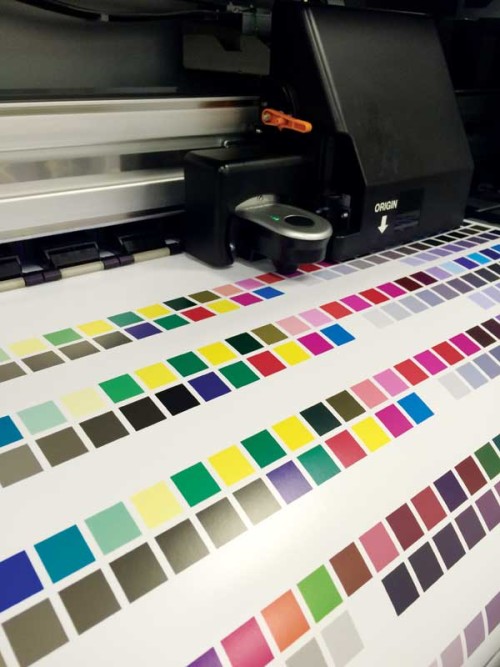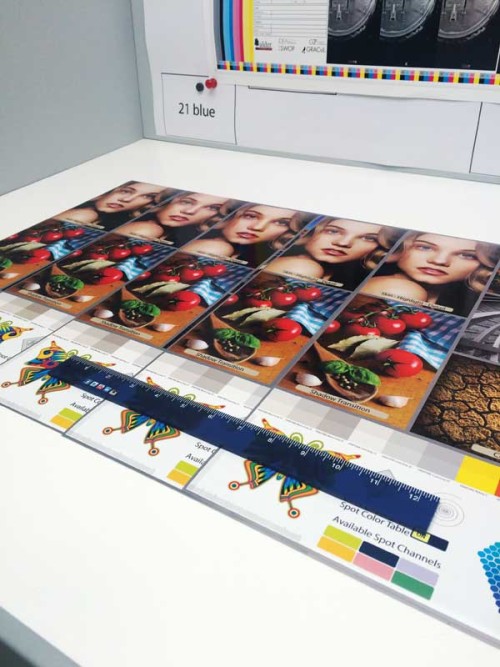A wide-format inkjet printer, on the other hand, creates colours using a subtractive process. The substrate starts out white and then inks are laid down on it to block light from reflecting back to the observer’s eye. Through printing combinations of cyan, magenta, yellow and key/black (CMYK) inks, less of the white material becomes visible. It may seem counterintuitive, but in theoretical terms, all of the colours of the job are in that white material to begin with.
Fortunately, technology can overcome the shortcomings and frailties of human eyes and the differences between additive and subtractive colour creation processes. Instead of building an ICC profile based on ‘measurements’ taken by eyesight, for example, a spectrophotometer is used to measure predefined colour swatches output by a printer or displayed on a monitor, taking subjectivity out of the process of measuring and reporting colour values.
A light booth should also be used when viewing colours for final approvals. This allows viewing conditions for the sample to be carefully controlled, including the viewing angle and illumination. A light booth can simulate daylight, store lighting or even incandescent residential lighting.
It is also important to use a high-quality computer display that can be calibrated. When a monitor is properly calibrated for colour, it will become possible—under controlled viewing conditions—to simulate finished print colours. This is no small feat, as it combines elements of both additive and subtractive colour processes, but with the proper colour measurement software and equipment, such calibration can be completed by just about anyone within a matter of minutes.

An on-board spectrophotometer measures colour targets output by the printer.
Printer calibration
The creation of a custom ICC profile should begin with the calibration of the printer. One way to achieve this is to use the linearization functions built into the RIP software, but in most cases, these functions do not linearize to a known standard printing condition. This can mean a problem after the custom colour profile has been created, as when the colour drifts, it is impossible to get back to the exact baseline printer calibration that was used to build the profile in the first place. The solution to this problem would be to relinearize and reprofile, a process that can take upwards of an hour to complete.
An alternative approach is to replace the RIP’s own linearization routine with a grey-balance calibration routine, such as the International Digital Enterprise Alliance’s (IDEAlliance’s) G7 methodology (see Sign Media Canada, April 2015, page 70). There are several significant benefits to this approach. First, the baseline printer output—even without a custom profile—will be grey-balanced and visually pleasing in terms of perceived colours. Secondly, since the G7 method achieves grey balance by calibrating the printer to a set of published standard aim points, it is possible to hit the same targets again and again.
There is also a benefit when using a calibrator tool that automatically generates ink restrictions to achieve G7 calibration. This way, when creating profiles in different locations, it will be easier to achieve very similar results, because the setting of ink restrictions is handled by software instead of human interpretation.
With both a custom profile and automatic ink limiting in the printer’s calibration software, it becomes possible not only to ensure precisely the right amount of ink is laid down on the substrate, but also to maximize the printer’s gamut so as to hit custom spot colours. And when colour drift occurs with a custom profile and a G7-calibrated printer, the profile can be recalibrated and rebuilt without having to print and measure an extensive custom profile target, turning a one-hour-plus process into a 15-minute fix.
Colour verification
One way to detect colour drift is visual observation, but this is usually not sufficient. By the time colour has drifted far enough to be noticed by the human eye, chances are the sign shop has already shipped poorly colour-matched prints to its clients.
Rather than wait until colour drift is visually noticeable, a spectrophotometer should be used periodically to measure a verification target. This will allow the shop to ensure it is still producing colour at qualities defined by an industry or in-
house standard.
A verification target can contain enough colour patches to enable evaluation of conformance to the G7-related ‘known good print conditions’ and updated printer calibration if a colour has drifted too far. The updated calibration can be imported into the RIP software to help generate an updated profile. Then, another verification target can be printed and measured to confirm the adjustments were sufficient to bring the colour back into specifications.

The key to the success of the G7 method is process control, based on a set of standard aim points.
Process control
The key to the success of the G7 methodology is process control. Just as coffee shops control such variables as the power of hydrogen (pH) level of their water to ensure their products taste the same across many locations, so too can sign shops maintain in-house processes at a consistent and repeatable manner.
Most of the ‘hard work’ of process control is already done once a sign shop has generated its baseline printer calibration and begun measuring its verification targets on a regular basis. The last step is to collect all of the measurements in a database for ongoing evaluation. Fortunately, many of today’s RIP software packages are designed for this purpose and will proactively provide the evaluation results. By taking note of trends in printed output, it even becomes possible to predict colour failures and recalibrate a printer before a verification target fails an inspection by spectrophotometer. The goal, after all, is to prevent failures before they happen.
Improving colour consistency
In these ways, small investments in software, measuring instruments and training can achieve better colour consistency for sign shops creating wide-format printed graphics. And these costs can quickly be recovered.
For one thing, the time and effort that would otherwise be spent on the phone with suppliers trying to track down a canned profile to get the desired colour out of a given ink-and-substrate combination can now be saved by developing and using custom ICC profiles. For another, a shop that follows through with regular colour verification measurements, ensuring all graphics going out the door showcase consistent, repeatable colour, is much less likely to have customers complain that one print run does not match another. Indeed, many such shops find clients bringing them more work to print.
Successful colour consistency begins with the creation of custom ICC profiles, continues throughout a workflow based on printer calibration, colour verification and process control and benefits from ongoing analysis over time.
Jim Raffel is co-founder and CEO of ColorMetrix Technologies, which develops cloud-based, cross-platform printer calibration, colour verification and process control software for wide-format inkjet printing. This article is based on a session he presented at the Specialty Graphic Imaging Association (SGIA) Expo in November 2015. For more information, contact him via e-mail at raffelj@colormetrix.com and visit www.sgia.org.





